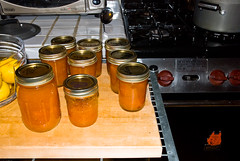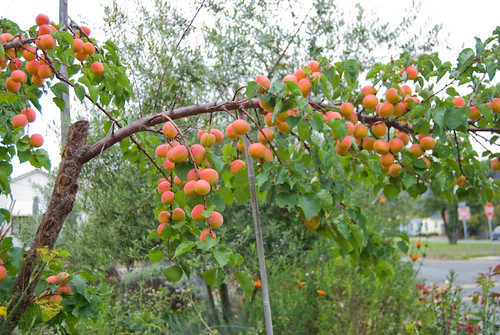Posts Tagged: apricot
Apricot Jam 2009
The apricot canning project this year was small but reasonably successful. I lost very few apricots due to my branch supports, and we ate lots of fresh ones. Finally the day came when they had to be picked, and I brought them all in. I kept them in the fridge to try to have fresh fruit on hand for as long as possible. But last night the time came to preserve the rest.
I couldn’t find the online recipe I used last year that included orange zest. But I had lots of lemons and so just went with the easiest thing I could find that called for some lemon juice. It also called for about 3/4 cup sugar to each cup fruit. I ran out of regular sugar a cup shy and so substituted brown sugar for the last cup. I like the slightly darker flavor it adds, but in retrospect, I probably should have just cut the sugar by a cup anyway. This batch is a bit sweeter than I remember the batch from last year being.
But it’s fun just the same and I’ve got jam to get me through the fall anyway. I guess canning is catching on. I heard this NPR story the other day on how canning classes are in demand as people try to revive this ancient alchemical skill in order to beat the bad economy. I can’t help thinking that there are all these things we as a society are doing totally wrong because we have been bamboozled into thinking that we can’t do anything ourselves, and that real happiness comes from buying everything and making nothing. We only get a glimpse of the truth when pushed by a crisis to rethink what we’re doing. Well, more on this in a future rant. Right now, I’m going to eat some some toast and jam.
apricot saga
About the apricot. In 2003 or so, I went down to Dwight Way Nursery and found this Blenheim apricot. It is supposed to be a dwarf or semi-dwarf, I can’t quite remember which.
I knew that there was some challenges to growing stone fruit around here. I know that they like a good cold winter to set fruit well, and, of course we don’t get much of that around here. A couple days of frost here and there is about it. Also, I know some people with peaches who report that periodically large chunks of the tree die for no apparent reason. Probably a blight that likes the relative dampness.
I chose apricot for a couple reasons. First, I thought that the smallness of the fruit might make it more likely that it will ripen. Secondly, my father planted an apricot at the house we moved to when I was five years old. That was a fabulous tree. It had a wonderful shape, an incredible crop almost every year, and the memory of it reminds me of my father. It lived for over 30 years until the renters i had in the house killed it and almost all the other fruit trees in the back yard through a couple fresno summers with no watering whatsoever.
In any case, my apricot produced no fruit the first season, about six or eight fruits the next couple seasons, and about a dozen last season. My friend Rocky had become fond of teasing me about the size of the cobbler he would be limited to in trying to do something with the “annual crop”. And last year, when the tree started the growing season with a perfectly balanced, bowl shape, and good new growth and budding, it suffered the mysterious die-back. One major branch on one side and a couple nearby small branches suddenly quit leafing, shriveled up, and died. The rest of the tree was basically okay, but it was misshapen and unbalanced. I put off my hopes to this year for both fruit and a return to form.
This year, there was not much weather during the spring. No hail, wind, or much rain came along to knock the beautiful blossoms from the tree. As the season progressed there was not a lot of new wood growth–not the several feet that previous years had seen. But it soon became obvious that there was a lot of fruit on the tree.
Around June 1st or so, my Neighbor Hugo said to me as we were admiring the tree, “you might get some 2x4s under a couple of those branches for support. You wouldn’t want them to break.” Well, I didn’t think this was much of a possibility. The aforementioned Fresno apricot never broke a branch no matter how laden with fruit. But after a couple of days, I took it more seriously, seeing that this young tree’s branches were still slender and there was a lot of fruit on them. What had been a narrow upright shape had now settled out into an open bowl of a branch structure. I propped them up with several bamboo sticks I had around.
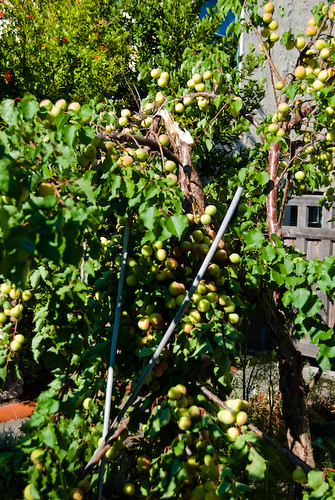
Then about a week later, we had a very windy night. I came out in the morning to find the largest branch of the tree broken, taking down about six feet of height from the tree and several pounds of not yet ripe fruit. I tried to salvage the fruit. Some, I picked and tried to ripen in a paper bag. Much of it I left on the broken branch in the hopes that what was left in the branch would continue to feed the fruit until it could ripen more. Each approach had success rate of about 2% of the fruit involved.
I was pretty disappointed, but there was still an incredible amount of fruit on the tree, so I got over it.
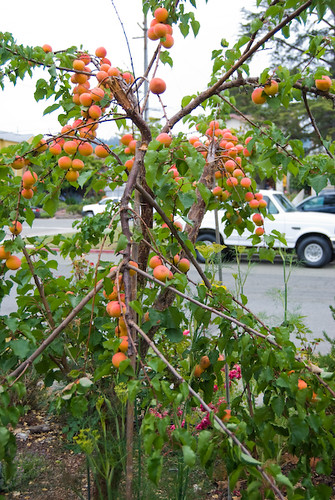
Then the other shoe dropped. About two weeks ago, not one, but two branches on the other side broke, despite being supported. There was a about 10 lbs. or more of fruit that had to be brought in. Fortunately, it was much closer to being ripe. I ripened much of it, and began eating it. As we did what was left on the tree, still a lot, was ripening and being brought in.
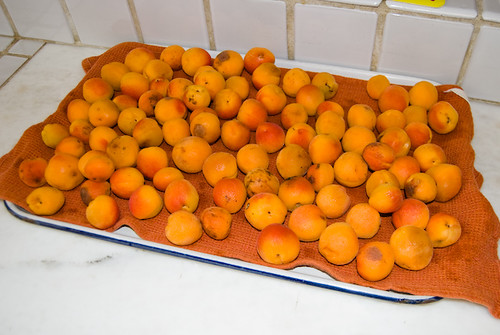
The past week we have been eating apricots like crazy. I gave some to Hugo next door. I gave some to my mom. We brought a bag to Fresno over the holiday. I made about four pints of preserves. I brought some to work. And still, we have a several pounds to pick and finish off the crop.

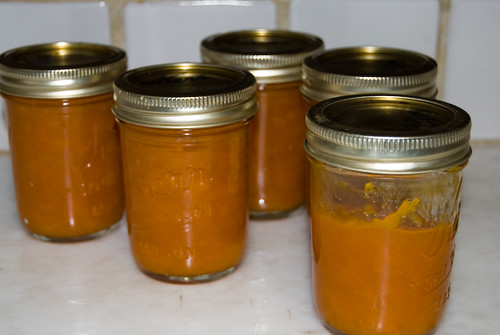
The lingering question is what the broken limbs mean for winter pruning, next spring growth, and the general shape and health of the tree. Only time will tell.
growing things
I live in Albany in the SF Bay Area. I like to garden, and I especially like to grow edible things. I am originally from Fresno, CA. Fresno is smack in the middle of the most productive agricultural region on the face of the planet. Collectively, these facts usually add up to some cognitive dissonance for me about this time of year.
In Fresno, you can grow practically anything and reap a bountiful harvest. In much of the Bay Area you can grow even more things, but the harvest part is much, much more challenging. This is often referred to as a “Mediterranean” climate, and to me, that brings to mind Greece. Note however, that Mark Twain did NOT say, “The coldest winter I ever spent was a summer in Athens”. The correct reference would be to San Francisco.
So while it is true that the climate in the Bay Area is mild and lots of things will grow, not everything fruits and ripens here. It just does not get hot enough for a sustained period for many fruit trees and vegetables like tomatoes and peppers to really produce a nice harvest. It gets frustrating because things do OK, but not great. Sometimes a plants, like tomatoes, just don’t look happy at all, no amount of feeding, watering, not watering, trimming, etc., cheers them up.
As with real estate so with gardening: location, location, location. I am still experimenting with varieties and locations. And admittedly, some things do just well. Lettuce comes to mind.
In the case of fruit trees, which no self-respecting Greek-American would omit from anything but the tiniest of gardens (for example pots on the apartment veranda), I began my efforts with a Blenheim apricot. But that is enough ranting for now; my experience with the apricot tree will be the subject of the next post.

